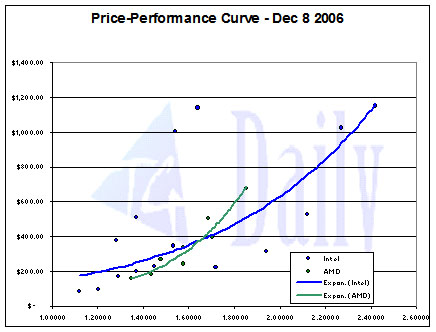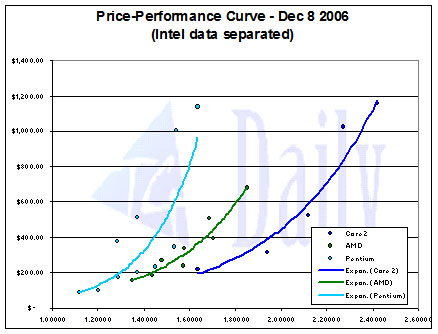Launch of 65 nm CPUs rings in new round of AMD retail price drops
Intel CPUs getting slightly more expensive
There are also a couple points to touch on with regard to Intel. Pricing is still in flux for the new QX6700, as the price jumped yet again, this time a 4%, $41 increase from $1113 to $1154. It looks like Thanksgiving week was the right time for early adopters to jump on the QX6700, at an average price of $1071. Historically, Intel Extreme Edition processors sold always in a range of above $1200 initially, which makes the QX6700, still a good buy, if you planned on purchasing the processor anyway.
Additionally, the biggest price shift came from the EX6800, which also went up in price this week, from $948 to $1027, a $79, 8% increase. Clearly we are seeing here the impact of Christmas demand, which also reveals itself further down in the list: The E6400, which (next to the E6300) has turned out to be the favored Core 2 Duo processor in Christmas systems, has gained 10% and now stands at $222.
There was an interesting dichotomy with the Extreme Editions. The EE 965 jumped 5%, or $50, from $1088 to $1138, a new record high for our charts. On the other hand, the EE 955 fell 6% to go down $63 from $1072 to $1009, which is a new record low. The two have been priced very close to each other for a while.
In fact, on November 10, they both were the same price, at $1071. However, there is a notable performance gap between the two, at least in relation to the jumps in performance between Intel's other bordering processors. So, this breakaway to a defined price differential does help in increasing Intel's price/performance correlation.
Since we've been mentioning records for AMD this week, let us add the improved the correlation value this week. AMD's correlation between price and performance reached the highest that we've ever recorded, at 0.942, an impressive 9.1% jump from last week's value of 0.864.
This week, we've decided to stop showing graphs that contain data from overclocked versions of Intel's processors, mainly because it essentially became just an echo of the graph without those data. Remember, though, that high-end processors, including the QX6700, do have substantial overclocking potential, which at least in theory holds value in itself. AMD processors on the other side, offer very little wiggle room for more clock speed. With that in mind, let's take a look at this week's graph.
Click image to enlarge and hget more detail
Get Tom's Hardware's best news and in-depth reviews, straight to your inbox.
As seen in the graph, all the AMD points are close to their associated trendline. The price drops also allowed AMD to continue to undercut Intel's line on the low end by more than we've seen before, pushing the intersection of the two back to the performance index level of nearly 1.7 and the price of $400.
Intel, while it didn't set a correlation record, also jumped from last week's 0.628 to 0.650, a 3.5% increase. This is significant because it comes after four consecutive weeks of Intel's correlation continuing to plunge downward.
Click image to enlarge and hget more detail
When we separate Intel into the Core 2 and Pentium lines, we can more clearly see the overall better correlation from last week and weeks prior. The Pentium processors showed a correlation this week of 0.787, up minimally from last week's 0.780. However, likely because of the price jumps of the top two processors, the correlation among Core 2 processors actually fell a bit this time around, down to 0.910 from 0.935.
As we publish this milestone 10th weekly processor/performance article, we would also like to remind our readers that we appreciate all feedback and suggestions for future installments. We read every comment that is sent and do our best to respond to them. As a reminder, readers can send comments about any article by clicking the hyperlinked author's name at the top of the article.

Mark Raby is a freelance writer for Tom's Hardware, covering a wide range of topics, from video game reviews to detailed analyses of computer processors.

